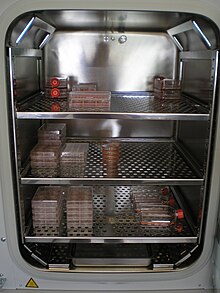Cell culture laboratory
A cell culture laboratory is a laboratory for cell culture .
properties
A cell culture laboratory is usually a laboratory for the culture of cells of multicellular origin. Due to the risk of contamination , work with cells is carried out under sterile conditions. The sequence of operations is set up so that the cells only come into contact with sterile materials. The establishment of the laboratory is based on the cells and cell lines used and the resulting biological protection level of the materials used, from which the biological safety level (BSL) of the laboratory results.
Laboratory equipment
Typical laboratory devices in a cell culture laboratory are e.g. B. an incubator usually with Kohlendioxidbegasung and humidity control , a safety cabinet for sterile work, an inverted microscope and a counting chamber to determine the viable cell count (alternatively, a Coulter Counter ), a centrifuge for separating cells and culture medium, a water bath for heating the culture media , an aspirator for sucking off liquids with a Woulfe bottle , a fridge- freezer combination for the short-term storage of biological material, a washbasin with a soap dispenser and a dispenser for disinfectants and an autoclavable garbage can (colloquially autoclave bucket ).
hygiene
The cell culture laboratory should only have the necessary horizontal surfaces to reduce the build-up of dust . The sink and autoclave pail are positioned in a more contamination-prone location in the laboratory, e.g. B. at the entrance of the room. Surfaces are cleaned at least once a week and the lab coats are changed. Consumables are only stored in the cell culture laboratory in monthly quantities. Cardboard boxes with consumables are stored outside the cell culture laboratory. Devices for the analysis , cryopreservation or cell disruption of the cells, which do not necessarily have to be sterile, are set up outside the cell culture laboratory, e.g. B. FACS or materials for immunohistochemistry , DNA , RNA or protein purification .
The floor covering of a cell culture laboratory is waterproof for easy cleaning, as seamlessly as possible and laid close circumferentially bent up at the edges. The surfaces in cell culture laboratories should be waterproof and pore-free.
Special forms
Special forms of a cell culture laboratory with additional requirements are IVF laboratories , GMP production laboratories and BSL-3 and BSL-4 laboratories. For genetic engineering work in Germany, a registration of the cell culture laboratory with the responsible state office and, depending on the biological protection level, a notification or approval of the work is required. In Germany, permission from the responsible state office is required for work with pathogens .


